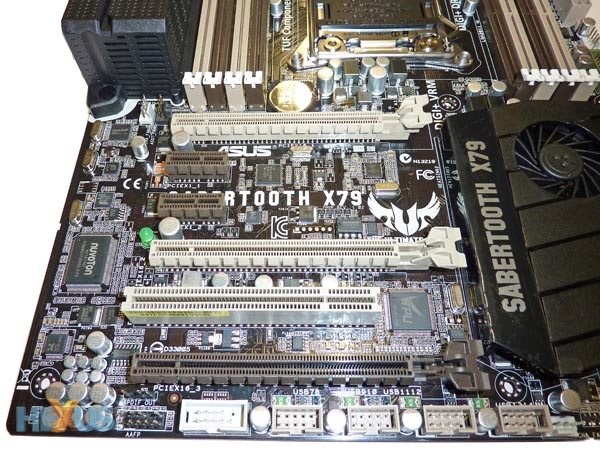Layout, features, BIOS
Layout is surprisingly decent for a board whose mid-section is reserved almost entirely for the CPU, but remember that Intel has now stripped away the need for a traditional northbridge - everything's contained in one chip.

Sabertooth is also well-specced from a general standpoint. On top of the two SATA 6Gbps and four SATA 3Gbps ports powered by the chipset, ASUS throws in a couple of SATA 6Gbps from Marvell, but what's more interesting is the inclusion of the company's own SSD caching on these two white-coloured ports - a technology similar to Smart Response - and reckoned to be better than Intel's solution as a performance-boosting SSD can be connected at any time, not just during installation.
A second fan is enclosed in a plastic-topped heatsink that covers the X79 chipset. Again 40mm in size its speed can be regulated in the BIOS (it can be unplugged if the noise is annoying). Supporting the various fans and giving enthusiasts something to while away the time, there are 12 sensors sensibly dotted around board whose readings can be viewed through a bundled Windows app.

Sabertooth's raison d'être isn't about ultimate graphics performance; the Rampage is the one to go for if quad-board running is your thing. Here, three x16 PCIe slots provide three-way multi-GPU usage in a x16, x16, x8 arrangement, making full use of X79's additional PCIe lanes. TUF X79 is PCIe 3.0-ready, according to ASUS, though, of course, such cards are yet to materialise.
Cards fit nicely over the right-hand heatsink though putting a large GPU in the topmost slot, which most will do, effectively blocks the fan right off. Perhaps it could do with being moved down a few centimetres? The upper PCIe x1 slot's positioning is such that it can get blocked off by a double-width card.

Four USB 3.0 ports are shown on the rear. Sabertooth adds in three ASMedia controllers for six-port support, meaning the remaining duo can be accessed by an on-board header, primed for an ASUS front-panel box, which is located next to the DIMM slots.
We like the look and feel of the Sabertooth X79. Layout is pretty good, it's armed with a sensible, but not over-the-top, array of features, and feels as if it's built to last. But what's much more difficult to stomach is the £250 retail price. Yup, this is no bargain, which isn't a criticism of ASUS per se as all initial X79 boards will cost £200-plus.
BIOS

The BIOS is comprehensive enough to make a novice user's head spin, and all of the settings are replicated in an operating-system environment through the company's AI Suite of utilities. We've long been fans of ASUS' UEFI BIOS, and the X79 chipset's adds a couple of tricks. First off, making it easier to navigate to the section you want by implementing a shortcut key.
Next up is what ASUS calls USB BIOS Flashback, which enables the user to load either a newer or older firmware ROM on the root drive of a USB key, and it's the first time we've seen it on a non-ROG board. The clever part of this procedure is that just a single button - next to the eSATA port on the I/O section - needs to be pressed for a couple of seconds. In fact, according to ASUS, all one needs is the motherboard connected to a power supply; other hardware isn't required. We've verified it works by flashing the board with no CPU or memory in sight. Cool, eh?

ASUS is also strong with respect to power and fan management, and there's enough voltage on tap to push all components to dangerously high levels.
But what's interesting, and more than a little naughty, is ASUS' behind-the scenes overclocking if setting the memory ratio manually. You see, when we first benched the board with a 3930K ES chip the benchmarks were coming in higher than expected. Digging further showed that ASUS's BIOS gives the CPU a boost, much akin to pressing F6 (overclocking). One has to manually set the Turbo Boost frequencies, which is more than a little annoying - especially, if like us, benchmarking is key.
Overall, the BIOS is solid, well-thought-out and replicated in Windows through the AI Suite. No complaints other than behind-the-scenes auto-overclocking.









